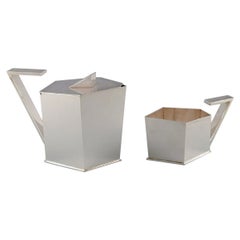Meurgey Paris
Recent Sales
Mid-20th Century Swedish Modern Sheffield and Silverplate
Silver Plate
A Close Look at modern Furniture
The late 19th and early 20th centuries saw sweeping social change and major scientific advances — both of which contributed to a new aesthetic: modernism. Rejecting the rigidity of Victorian artistic conventions, modernists sought a new means of expression. References to the natural world and ornate classical embellishments gave way to the sleek simplicity of the Machine Age. Architect Philip Johnson characterized the hallmarks of modernism as “machine-like simplicity, smoothness or surface [and] avoidance of ornament.”
Early practitioners of modernist design include the De Stijl (“The Style”) group, founded in the Netherlands in 1917, and the Bauhaus School, founded two years later in Germany.
Followers of both groups produced sleek, spare designs — many of which became icons of daily life in the 20th century. The modernists rejected both natural and historical references and relied primarily on industrial materials such as metal, glass, plywood, and, later, plastics. While Bauhaus principals Marcel Breuer and Ludwig Mies van der Rohe created furniture from mass-produced, chrome-plated steel, American visionaries like Charles and Ray Eames worked in materials as novel as molded plywood and fiberglass. Today, Breuer’s Wassily chair, Mies van der Rohe’s Barcelona chair — crafted with his romantic partner, designer Lilly Reich — and the Eames lounge chair are emblems of progressive design and vintage originals are prized cornerstones of collections.
It’s difficult to overstate the influence that modernism continues to wield over designers and architects — and equally difficult to overstate how revolutionary it was when it first appeared a century ago. But because modernist furniture designs are so simple, they can blend in seamlessly with just about any type of décor. Don’t overlook them.
Finding the Right sheffield-silverplate for You
Sheffield silverplate is a durable combination of thin silver sheets and comparatively thicker sheets of copper that was used to create a variety of household objects for years. On 1stDibs, find a collection of antique and vintage Sheffield silverplate and other silverplate for all of your formal dining and entertaining needs.
A cutler named Thomas Boulsover, who worked for a cutlers company in Sheffield, England, accidentally invented what we now call Sheffield silverplate during the 1700s. While working on a decorative knife for a customer — the metalworkers guild had been tasked with repairing its handle — Boulsover mistakenly overheated the silver and noticed that the knife’s layers of silver and copper melded together, creating an impressive bond. This new material felt like silver but was substantially cheaper. It was then used to produce a variety of serveware, candlesticks, buttons, tea sets and more. For families that couldn’t afford the sterling-silver tureens that were used to serve soup in the upper-class English homes at the time, this was good news. They could impress guests with housewares that looked like sterling silver but actually weren't.
Today, just as pewter collectibles and sterling silver are popular with collectors at neighborhood flea markets, antique Sheffield silverplate housewares are sought after for their appearance and rich history. Sheffield silverplate can command high prices on the secondhand market.
Securing yourself a Sheffield silverplate piece is like acquiring a little bit of history. In order to identify authentic Sheffield silverplate, you need to look for one significant attribute of the material. A metalworker had to ensure that all of the exposed edges of a particular piece had to be covered with a rim of silver. If not, the middle layer, which comprised copper, would show through. This would reveal that the piece was not sterling silver.
Don’t just trot out your matching crystal, silver and porcelain once or twice a year. Make a habit of mixing high and low when setting the table. To pair with your everyday contemporary tableware, find antique and vintage Sheffield silverplate on 1stDibs as well as silverplate by goldsmith and tableware companies such as Christofle, Elkington & Co. and more.
